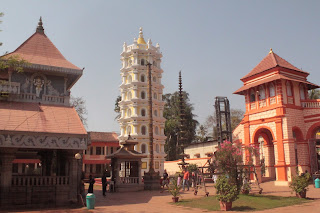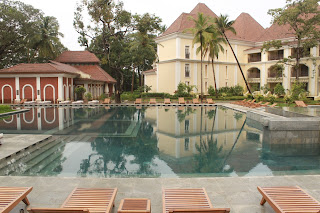Goa is perhaps India's most preferred travel destination when it comes to fun-packed, laid-back, relaxed holidays. It's like the Indian equivalent of Hawaii, Bali or Phuket. I first went to Goa in 2010 and spent three days there exploring its various sites. I stayed in a three star hotel in Candolim. I again went later that year on a family holiday and spent a couple of days there. My parents, my two sisters, my niece and I stayed at a large mansion belonging to a family friend. It sadly happened to be the last of many family holidays with my parents (my father was close to 80 then and my mother was around 75, and they tragically left us in 2013 and 2019 respectively), but it was a very memorable trip and my parents both enjoyed it immensely. I then went to Goa with my fiance in 2011 and we spent three days there. This time, accommodation was at Grand Hyatt Goa. A few years later, in 2015, my college batch from XLRI Jamshedpur had its 20th anniversary reunion in Goa, and about half our batch strength of around 130 made it for the event. The reunion was at Zuri White Sands, and it was a wonderful couple of days spent with old friends, a few of whom I was meeting after 20 years. So across my various visits, I have spent a total of around 10 days in Goa, and I've had a chance of seeing many of its main attractions.
Goa is a state in western India in
the Konkan
Region of the country and it lies along the coast of the Arabian Sea. It has a
population of just over 1.4 million, and an area of about 3,700 sq km, making
it one of the least populated and smallest states in India. Goa’s capital is Panaji, a
town with a population of just over 40,000. Goa has the highest per capita
income in the country. It is a very popular tourist destination, both with
international and domestic tourists, on account of its white sand beaches, its
nightlife, its cuisines, its easy going pace of life, and the splendid churches
in Old Goa.
The Portugese
landed in Goa in the 16th century as merchants, and soon they occupied it. It became a Portugese
colony for more than four centuries. It became a part of India in 1961. The Portugese
refused to hand over Goa after India’s independence from the British in 1947,
and the Indian Army finally annexed it. Goa, Daman and Diu became a Union
Territory of India. In 1987, the Union Territory was split and Goa became
India’s 25th state, while Daman and Diu remained
a Union Territory. Portugese influence still remains in Goa,
through the state’s architecture, its churches and its culture.
Old
Goa is a town on the
southern banks of the Mandovi River. It served as
the capital of Portugese India from the 16th century till the 18th century, when it was hit by the plague and abandoned. The town has a population of about 2,500. Old
Goa is a UNESCO World Heritage Site known for its churches.
Old Goa’s three most important churches are Basilica of Bom Jesus, Se Cathedral
and Church of St Francis of Assisi.
Other churches include St Cajetan Church, Royal Chapel
of St Anthony, Ruins of Church of At Augustine, Chapel of St Catherine, St
Anne’s Church, Church of Our Lady of Rosary, Church of Our Lady of Mount and
Church of St John of God.
Basilica
of Bom
Jesus lies in Old Goa. It
has the mortal remains of St Francis Xavier, one of the founders of the Society
of Jesus, who died in 1552. The church was built by the Portugese and consecrated in
1605. Its floor is made of marble, inlaid with stones. The high altar has a
statue of St Ignatius of Loyola, a friend of St Francis Xavier’s. The
mausoleum, above which lies the silver casket with the remains of St Francis
Xavier, was a gift of the last Medici, Cosimo
III, the Grand Duke of Tuscany.
 |
| Basilica of Bom Jesus |
 |
| High Altar, Basilica of Bom Jesus |
 |
| Crucifixion Statue, Basilica of Bom Jesus |
 |
| Tomb of St Francis Xavier, Basilica of Bom Jesus |
 |
| Statue of St Francis Xavier, Basilica of Bom Jesus |
Se
Cathedral was consecrated in
1640. It was built to commemorate the victory of the Portugese over a Muslim army,
which led to the Portugese taking over Goa in
1510. The high altar is dedicated to Catherine of Alexandria. Theo church has
one tower. It originally had two but one collapsed in 1776 and was never
rebuilt. Se Cathedral is situated in Old Goa.
 |
| Se Cathedral |
 |
| High Altar, Se Cathedral |
Church
of St Francis of Assisi in
Old Goa was built by the Portugese in 1661. The façade
has octagonal towers on either side. The high altar has a statue of St Francis
of Assisi, and Jesus on the Cross. Below these, there are statues of St Peter
and St Paul.
 |
| Church of St Francis of Assisi |
 |
| Ceiling, Church of St Francis of Assisi |
St
Catejan Church is
located in Old Goa and was built in 1661. The church was modelled along the
lines of St Peter’s Basilica in Vatican City. The church has a large dome. It
has seven altars, the main one dedicated to Our Lady of Providence. The
inspiration for the church came from three Italian priests of the Theatine order who came to
India in 1639.
 |
| St Catejan Church |
 |
| High Altar, St Catejan Church |
Royal
Chapel of St Anthony was
built in the 17th century and is in Old Goa. It is dedicated to St Anthony, the
patron saint of the Portugese army and navy.
 |
| Royal Chapel of St Anthony |
Our
Lady of the Immaculate Conception Church is situated on top of a small hill in Panaji (formerly known as Panjim), and was built by
the Portugese in the 17th century, replacing an earlier church built in 1541. The famous symmetrical
zigzag stairway in front of the church was added in the 18th century. The baroque church is dedicated
to Mother Mary.
 |
| Our Lady of the Immaculate Conception Church |
The Old Secretariat in Panaji originally housed
the Portugese viceroys, before
becoming a government office. The Statue of Abbe de
Faria lies outside the Old
Secretariat. The monk, who lived from 1756 to 1819, was born in Goa. He was one
of the pioneers of hypnotism.
 |
| Old Secretariat |
 |
| Staue of Abbe de Faria, Old Secretariat |
Azad
Maidan is located in Panaji. In 1843, a statue
of the Portugese general Afonso de Albuquerue was installed there.
After the annexation of Goa, the statue was removed. The Martyrs’ Memorial was
installed in 1973 commemorating those who died in the liberation of Goa. The
memorial is a tall structure with a crest at the top.
 |
| Martyrs' Memorial, Azad Maidan |
Miramir Beach is
a beach in Panaji. The beach lies at
the confluence of the River Mandovi and the Arabian Sea.
Miramir Beach is very
popular with tourists. The Twin Statues at Miramir
Beach were erected in 1972, showcasing the unity between Goa’s two largest
communities.
 |
| Miramir Beach |
Braganza
House was built in the 17th century and is situated in Chandor Village. It was
owned by the Pereira-Braganza family, and was given by King Dom Luis of
Portugal. The house is famous for its furniture and artefacts. The big ballroom
has an Italian marble floor and a large
European chandelier. Other treasures include Chinese porcelain, family
portraits and a library.
 |
| Braganza House |
 |
| Vase, Braganza House |
 |
| Great Hall, Braganza House |
Mahalsa Narayani Temple lies
in Mardol. It is dedicated to Mohini, a female avatar of
Lord Vishnu. The temple dates back to the 17th century. The
original temple was destroyed by the Portugese in
1567.
 |
| Mahalsa Narayani Temple |
Mangueshi Temple lies
in Ponda. The temple has been
rebuilt on a couple of occasions, and the current structure dates back to 1890.
The temple is dedicated to Bhagavan Manguesh, an incarnation of
Shiva. The temple has a prominent 7 story lamp tower.
 |
| Mangueshi Temple |
The
Leela Goa is located in Cavelossim and is one of Goa’s
top resorts. It has a 12 hole golf course, an outdoor pool, a spa, tennis,
pottery making classes, and multiple dining options. The attached beach is full
of coconut palms.
 |
| Golf Course, The Leela Goa |
 |
| Beach, The Leela Goa |
 |
| Dome at the entrance, The Leela Goa |
Taj Holiday Village Resort and Spa is situated in Candolim along the coast. It
has terracotta-roofed cottages and is spread over 28 acres. It has a large
outdoor pool with a sunken bar and buffet breakfast, a spa, a golf course. The
Beach House is known for seafood and Goan
specialities . There is also a Thai restaurant.
 |
| Caravela Restaurant, Taj Holiday Village Resort and Spa |
 |
| Hammock, Taj Holiday Village Resort and Spa |
 |
| Pool, Taj Holiday Village Resort and Spa |
Taj Fort Aguada Resort and Spa is spread over 73 acres. It is right next to Fort Aguada in Candolim, overlooking the
Arabian Sea. The hotel has multiple dining options, including all-day dining at
the multi cuisine restaurant, Latitude. Facilities at the resort include a spa,
a pool, tennis, squash and water sports. There is also mini golf and a library.
 |
| Taj Fort Aguada Resort and Spa |
Grand
Hyatt Goa lies in Bambolim. The resort is
spread over 28 acres, and its facilities include an outdoor pool, an indoor
pool, a spa, multiple dining options. The resort is lush green and has an
attached private beach.
 |
| Pool, Grand Hyatt Goa |
 |
| Rooms, Grand Hyatt Goa |
 |
| Interior, Grand Hyatt Goa |
Calangute Beach lies
in North Goa. It is the largest of North Goa’s beaches and is very popular with
tourists. It offers a variety of water sports, and is full of shacks serving
local seafood. Calangute is a town with
13,000 inhabitants.
 |
| Calangute Beach |
Colva Beach is
in South Goa. The sand white beach stretches for 2.5 km. It is lined with
coconut palms. Colva itself is a small
coastal village, full of budget hotels, guest houses, beach shacks, restaurants
and pubs.
 |
| Colva Beach |
Sahakari Spice Farm is situated in Ponda. The farm has dense forest cover and has a variety of spices including vanilla, cinnamon, cardamom, pepper, curry leaves, turmeric and ginger. Guided tours are available at the farm. One can also have a traditional Goan meal, served in earthen pots and eaten on banana leaves
 |
| Sahakari Spice Farm |
Goa really is a remarkable state. For me, the highlights were the churches of Old Goa, the white sand beaches along the coastline, the food at the inexpensive but vibrant beach-side food shacks, the Goan cuisines at some of the restaurants (Mom's Kitchen in Panaji was a place I really liked), the luxurious resorts, the colourful architecture, the friendly people and the easy pace of life. Several people I know have given up life in the big metros of India and settled down to the slower but happier pace of life in Goa. Whether one is visiting Goa or living there, it is undeniably a marvelous place.



































No comments:
Post a Comment